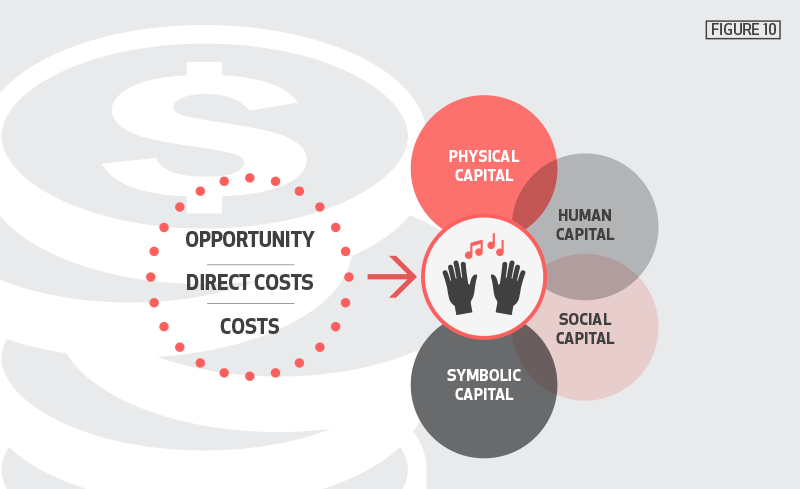UTAS Research
Live Music Capital
The various benefits described by consumers and producers in relation to live music have a clear intrinsic value. These benefits can also be related to various forms of ‘capital’, being outcomes of (and therefore motivators to) live music engagement.
In neo-classical economics, capital and labour are theorised as the most common inputs in the production of goods and services. In economic analysis the term capital is used to understand the work of the tools and machines that produce these goods and services. This allows economists to price the work of these tools and machines in aggregate. This is useful for economic analysis and modelling but is also a potential weakness, as it assumes the various machines and tools employed can be directly compared to one another.
For example, the capital stored in a live music venue might be quantified by its potential to produce a given number of live music shows in a year. Theoretically the more live music venues there are, the higher this production potential would be and the greater the capital. Measuring capital in this way assumes it is stored or conserved in the tools used to produce it (in this case live music venues) and that this value remains mostly static.
This study departs from the neo-classical use of the term and instead views capital as an output of the production process. The concept of capital as a ‘stored potential’ is not rejected by this approach, but is seen as less significant for the purpose of valuing live music production than how that potential is ultimately expressed. It is only when citizens collectively express their capital that its effect can be measured and reconciled with costs to arrive at estimates of value.
For example the capital stored in a live music venue might be expressed as profits generated for producers or jobs created. The effect of these expressions of capital can be measured and compared with the venue’s costs to calculate an estimate of economic value. This valuation will depend on a significant number of environmental variables, including, among other things: the quality of raw inputs (performers, equipment, food and beverage offerings); operator skill; and wear and tear.
This more accurately describes the realities of live music production and is consistent with recent attempts to understand capital as more than just skills and tools.
For example, contemporary economic theory abounds with models claiming to illustrate different aspects and interpretations of capital including, but not limited to:
- Aesthetic capital (Anderson, Grunert, Katz, & Lovascio, 2010)
- Cultural capital (Bourdieu, 1993; L. Johnson, 2006)
- Economic capital (Laeven & Goovaerts, 2004)
- Social capital (R. D. Putnam, 2000; Woolcock, 1998)
- Symbolic capital (De Clercq & Voronov, 2009; DiMaggio & Useem, 1978)
- Erotic / sexual capital (Hakim, 2010; Michael, 2004)
- Human capital (Marx, 1859; Smith, 1828)
- Intellectual capital (Stewart & Ruckdeschel, 1998; Teece & Teece, 2000)
- Knowledge capital (Carr, Markusen, & Maskus, 1998; Lööf & Heshmati, 2002)
- Natural capital (Costanza et al., 2007; Ress & Wackernagel, 1996)
- Psychological capital (Luthans, Youssef, & Avolio, 2007)
- Spiritual capital (Finke, 2003; Iannaccone & Klick, 2003)
A rigorous valuation of live music in Australia requires that we account for the various forms of capital that can be attributed to the activities live music enables. Because capital is viewed as an output of the production process in this study, we have focused on forms of capital that identify discrete outcomes which can be traced back to live music production and the costs involved.
Live music capital, therefore, lies at the nexus between inputs (costs) and outputs and is understood to be a non-substitutable attribute that accrues discretely within individuals, and collectively in firms and the community. This capital can, theoretically at least, be expressed positively—for example, to promote social inclusion (Gibson & Homan, 2004; Sedita, 2008; Thornton, 2013)—or negatively—for example, to promote harmful of offensive ideals (Armstrong, 2001; Binder, 1993; Phillipov, 2011).
Economic expressions of this capital will be unique to the social setting (in this case, Australia), even though the potential for good or bad within it is theoretically uniform. All things being equal, the more widespread and/or intense the participation of the community, the greater the impact live music making in Australia will have on these factors.
The definition of capital used here is not intended to rebut alternative descriptions of live music capital; for examples, see Stempel (2006) and Lee, Cornwell, and Babiak (2013). Instead of trying to distinguish the value of live music production from the traditional economic forms of capital, this study integrates all definitions to embrace and capture a holistic spectrum of value. Because we are concerned with measuring the way capital is expressed, rather than its stored potential, the value of this capital per se is irrelevant and no attempt is made to quantify it. Nevertheless, articulating live music capital in this way serves to identify the different ways it might be expressed and the forms of input that contribute to these activities.
Drawing on the body of literature outlined in the introduction and qualitative data presented in the previous section we have identified four domains of capital in the context of live music making in Australia.
Figure 10: Forms of live music capital
